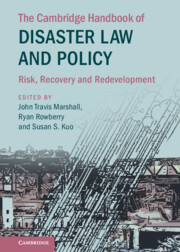Book contents
- The Cambridge Handbook of Disaster Law and Policy
- The Cambridge Handbook of Disaster Law and Policy
- Copyright page
- Dedication
- Contents
- Figures
- Maps
- Tables
- Contributors
- Foreword: Current Trends in Disaster Law and Policy
- Acknowledgments
- Introduction
- Part I Critical Perspectives on the Evolution of Disaster Law and Policy
- Part II Effective Governance as an Imperative for Responsive Disaster Law and Policy
- Part III Law’s Role in Promoting Hazard Mitigation: Intergovernmental, International, National, and Local Approaches
- 9 Local Resilience, Land Use Law, and Disaster Planning
- 10 Financing City Resilience
- 11 Disaster, Land Use, European Union Law and the Impact on EU Member States: The Relevance of the 2019 Decision of the Dutch Supreme Court Ordering Cuts in Greenhouse Gas Emissions
- 12 Covid-19 and Cooperation in Times of Disaster
- 13 Disaster Recovery in Rural Communities
- 14 Wildfire Federalism: A Framework for Local Government Participation in Disaster Planning
- 15 A Comparative Review of Hazard-Prone Housing Acquisition Laws, Policies, and Programs in the United States and Aotearoa New Zealand: Opportunities to Improve Practice
- 16 Urban Transformation as a Resilience Strategy: Earthquake Preparedness in Istanbul
- 17 How Do Green Cities Prevent Disasters?
- 18 Constructing a Resilient Energy Supply
- 19 Building a Resilient Power Grid
- 20 Weaponizing Private Property and the Chilling Effect of Regulatory Takings Jurisprudence in Combating Global Warming
- Part IV Private Sector Initiatives to Promote Disaster Resilience and Recovery
- Part V Lawyers As Disaster Law and Policy Leaders: Training for Students and Guidance for Practitioners
- Part VI Cultural Heritage Protection and Cross-Disciplinary Opportunities for Advancing Disaster Law and Policy
- Part VII Disasters and Vulnerable Communities
19 - Building a Resilient Power Grid
from Part III - Law’s Role in Promoting Hazard Mitigation: Intergovernmental, International, National, and Local Approaches
Published online by Cambridge University Press: 27 October 2022
- The Cambridge Handbook of Disaster Law and Policy
- The Cambridge Handbook of Disaster Law and Policy
- Copyright page
- Dedication
- Contents
- Figures
- Maps
- Tables
- Contributors
- Foreword: Current Trends in Disaster Law and Policy
- Acknowledgments
- Introduction
- Part I Critical Perspectives on the Evolution of Disaster Law and Policy
- Part II Effective Governance as an Imperative for Responsive Disaster Law and Policy
- Part III Law’s Role in Promoting Hazard Mitigation: Intergovernmental, International, National, and Local Approaches
- 9 Local Resilience, Land Use Law, and Disaster Planning
- 10 Financing City Resilience
- 11 Disaster, Land Use, European Union Law and the Impact on EU Member States: The Relevance of the 2019 Decision of the Dutch Supreme Court Ordering Cuts in Greenhouse Gas Emissions
- 12 Covid-19 and Cooperation in Times of Disaster
- 13 Disaster Recovery in Rural Communities
- 14 Wildfire Federalism: A Framework for Local Government Participation in Disaster Planning
- 15 A Comparative Review of Hazard-Prone Housing Acquisition Laws, Policies, and Programs in the United States and Aotearoa New Zealand: Opportunities to Improve Practice
- 16 Urban Transformation as a Resilience Strategy: Earthquake Preparedness in Istanbul
- 17 How Do Green Cities Prevent Disasters?
- 18 Constructing a Resilient Energy Supply
- 19 Building a Resilient Power Grid
- 20 Weaponizing Private Property and the Chilling Effect of Regulatory Takings Jurisprudence in Combating Global Warming
- Part IV Private Sector Initiatives to Promote Disaster Resilience and Recovery
- Part V Lawyers As Disaster Law and Policy Leaders: Training for Students and Guidance for Practitioners
- Part VI Cultural Heritage Protection and Cross-Disciplinary Opportunities for Advancing Disaster Law and Policy
- Part VII Disasters and Vulnerable Communities
Summary
When I dream about Hurricane Katrina, it always starts with the refrigerators. Kenmore, GE, Whirlpool, Frigidaire, Amana. Hundreds of thousands of these abandoned appliances stood duct-taped shut on the curbs and yards of homes throughout New Orleans. Katrina refrigerators are not the only, or even the most dramatic, example of the perils of power outages in extreme weather. From rancid food to emergency-room nightmares, communities take a punch when the lights go out. The nation’s aging power grid leaves us more susceptible to such risks. And the growing intensity of floods and storms on account of climate change make things even worse. But Katrina was not the only, or even the loudest siren blow. Since that time, storms have smashed or drowned parts of the grid in the Northeast (Hurricane Sandy), Houston (Harvey), the Southeast (Irma), and, most tragically, in Puerto Rico, where in 2018, Hurricane Maria knocked out 80% of the island’s electricity network, causing the largest blackout in U.S. history. In the same decade, catastrophic wildfires in Northern California focused attention on the neglected and antiquated system operated by Pacific Gas & Electric, which is believed to have ignited several devastating blazes over two years. Killing at least 84 people and destroying billions of dollars in property, the fires also required cycles of deliberate blackouts to protect parched forests from even more incendiary failures. In this way, the grid became both a cause and a victim of violent disaster. We need a power grid that is more resilient – one that has the capacity to cope with the kinds of low-frequency, high-impact events like those described above. In this chapter, I hope to show how we might get there. I’ll explain what the grid is, describe some of the grid’s most serious vulnerabilities – emphasizing the link to climate disruption and the outsized risks faced by marginalized groups – and propose some first steps toward making the grid more resilient and more productive for all.
- Type
- Chapter
- Information
- The Cambridge Handbook of Disaster Law and PolicyRisk, Recovery, and Redevelopment, pp. 313 - 326Publisher: Cambridge University PressPrint publication year: 2022



